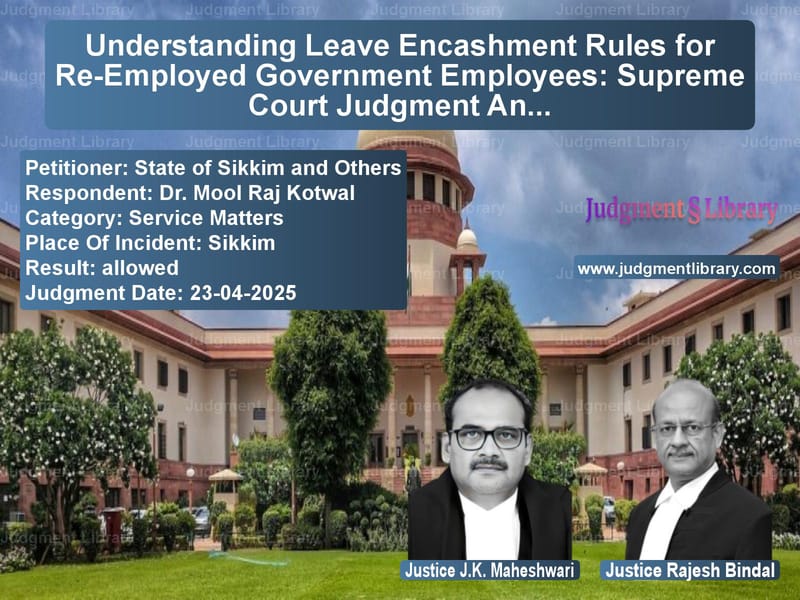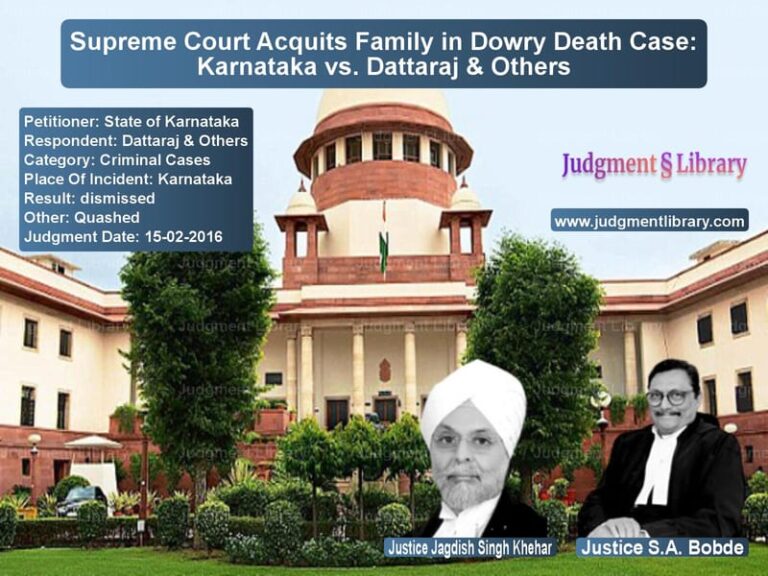Understanding Leave Encashment Rules for Re-Employed Government Employees: Supreme Court Judgment Analysis
The Supreme Court of India recently delivered a significant judgment in the case of State of Sikkim and Others vs. Dr. Mool Raj Kotwal, addressing the contentious issue of whether a re-employed government employee is entitled to leave encashment benefits a second time after their initial retirement. This case has far-reaching implications for government employees and the interpretation of service rules, particularly the Sikkim Government Services (Leave) Rules, 1982.
The dispute centered around Dr. Mool Raj Kotwal, who retired from his regular service as ‘Medical Advisor and Chief Consultant’ at the age of 58 in 2005. Upon retirement, he was granted leave encashment for a maximum of 300 days of unutilized leave, as per Rule 36 of the Leave Rules. Subsequently, he was re-employed for over 14 years and, upon relieving from re-employment in 2019, sought leave encashment again for the unutilized leave accumulated during his re-employment period. The State of Sikkim, however, canceled this benefit, citing that the Leave Rules do not permit such double benefits.
The High Court of Sikkim initially ruled in favor of Dr. Kotwal, interpreting Rule 32 of the Leave Rules to mean that re-employed employees should be treated as new entrants, thereby making them eligible for leave encashment again. However, the Supreme Court overturned this decision, providing a detailed analysis of the relevant rules and their legislative intent.
Key Arguments of the Petitioners (State of Sikkim)
The State, represented by Mr. Sameer Abhyankar, argued that Rule 36 of the Leave Rules explicitly limits leave encashment to a maximum of 300 days upon retirement from regular service. They contended that the rule does not extend to re-employed employees, as re-employment is distinct from regular service. The State emphasized that the clarificatory order issued on 27.02.2020 was aimed at rectifying a systemic error where re-employed employees were erroneously granted leave encashment twice. The State further asserted that Rule 32, which treats re-employed employees as new entrants for leave purposes, does not override the specific limitations imposed by Rule 36.
Key Argument: “Rule 36 prescribes leave encashment maximum of 300 days after retirement on attaining the age of superannuation as specified in Service Rules. It was noticed that employees who were re-employed after retirement were availing benefit of leave encashment of the leave available in their credit after being relieved. On examining the issue, the government found that grant of such benefit is not as per the spirit of Rule 36 of Leave Rules.”
Key Arguments of the Respondent (Dr. Mool Raj Kotwal)
Dr. Kotwal, represented by senior counsel Mr. A. Mariarputham, argued that the cancellation of his leave encashment benefit was arbitrary and violated principles of natural justice, as no opportunity was given to him before the cancellation. He also claimed discrimination, as other similarly situated re-employed employees had been granted the same benefit. Dr. Kotwal relied on Rule 32, which states that re-employed employees should be treated as new entrants, thereby making the Leave Rules applicable to them afresh. He contended that this included the benefit of leave encashment under Rule 36.
Key Argument: “Rule 32 applies to the re-employed government servants alike an employee entered into service at first instance. Leave Rule 36 also applies to the employees on whom Leave Rules are applicable, however, on conjoint reading, the grant of benefit of leave encashment, again to re-employed employee is not prohibited.”
Supreme Court’s Analysis and Decision
The Supreme Court, comprising Justices J.K. Maheshwari and Rajesh Bindal, meticulously analyzed the interplay between Rules 32 and 36 of the Leave Rules. The Court observed that Rule 36 is specifically designed for employees retiring from regular service under the Sikkim Government Service Rules, 1974, and not for those re-employed thereafter. The Court emphasized that the legislative intent behind Rule 36 was to provide leave encashment as a one-time benefit upon retirement, capped at 300 days.
Key Observation: “Rule 36 cannot be read in a manner to revive the 300 days of unutilized leave afresh for the re-employed employees who have already availed the benefit of leave encashment maximum of 300 days during regular service. As such, there is no interplay of Rule 32 with Rule 36 and both are independent and apply in different spheres.”
The Court also highlighted the jurisprudential principles underlying leave encashment, noting that it is a form of deferred compensation for unutilized leave during regular service. Allowing such benefits multiple times would lead to unjust enrichment and impose an undue financial burden on the State.
Key Principle: “Jurisprudentially, leave encashment is grounded in two key principles: equity and economic security. The principle of equity ensures that employees who forgo their right to take leave for the benefit of the organization are not deprived of its monetary value. The principle of economic security treats leave encashment as a form of deferred wages, similar to gratuity or pension benefits.”
Ultimately, the Supreme Court set aside the High Court’s judgment, ruling that Dr. Kotwal was not entitled to leave encashment a second time after his re-employment. The Court upheld the State’s clarificatory order and affirmed that the Leave Rules do not permit double benefits for re-employed employees.
Conclusion
This judgment clarifies the scope of leave encashment benefits under the Sikkim Government Services (Leave) Rules, 1982, and reinforces the principle that such benefits are intended as a one-time entitlement upon retirement from regular service. The decision underscores the importance of adhering to legislative intent and avoiding interpretations that could lead to financial strain on public resources. For government employees, particularly those in Sikkim, this ruling serves as a reminder of the limitations imposed by service rules and the need to understand their entitlements clearly.
Petitioner Name: State of Sikkim and Others.Respondent Name: Dr. Mool Raj Kotwal.Judgment By: Justice J.K. Maheshwari, Justice Rajesh Bindal.Place Of Incident: Sikkim.Judgment Date: 23-04-2025.Result: allowed.
Don’t miss out on the full details! Download the complete judgment in PDF format below and gain valuable insights instantly!
Download Judgment: state-of-sikkim-and-vs-dr.-mool-raj-kotwal-supreme-court-of-india-judgment-dated-23-04-2025.pdf
Directly Download Judgment: Directly download this Judgment
See all petitions in Employment Disputes
See all petitions in Pension and Gratuity
See all petitions in Public Sector Employees
See all petitions in Termination Cases
See all petitions in Workplace Harassment
See all petitions in Judgment by J.K. Maheshwari
See all petitions in Judgment by Rajesh Bindal
See all petitions in allowed
See all petitions in supreme court of India judgments April 2025
See all petitions in 2025 judgments
See all posts in Service Matters Category
See all allowed petitions in Service Matters Category
See all Dismissed petitions in Service Matters Category
See all partially allowed petitions in Service Matters Category







